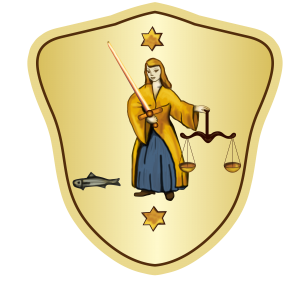Alten-Buseck, Australia, and United States; from 1780 (updated July19, 2025)
In our family storyline we have to return to Alten-Buseck, where in 1756 Johann Philipp Seuling and his spouse Anna Clara Wagenbach had a third son, Johannes. Some twenty-five years later, he married Justina Christina Voltz, most often referred to as Christine; in 1813 we find his family in the parental home in the Großen-Busecker Straße 28. Of their six children, three grew families of their own: Johann Caspar, Johann Philipp, and Johann Jost (Justus).


Postcards from Alten-Buseck.[1]

Offspring of Johannes Seuling (1756-1816).
Johann Caspar
Oldest son John Caspar (1785-1848) married twice, first in 1811 with Anna Margaretha Becker and a second time in 1824 with Maria Margaretha Einhäuser.

Offspring of Johann Caspar (1785-1848).
From his ten children out of both marriages, it appears only three sons born to Anna Margaretha had offspring carrying the name Seuling into the eighth generation following archfather Philipp: Johannes, Johann Philipp, and Johann Kaspar.
Johannes, born in 1812, married Maria Döll; in 1831 they had set up their household at Daubringer Straße 19. Little is known of their two sons Johann Philipp (born 1841) and Wilhelm (1843-1895) except for the fact that the latter apparently drowned in the river Lahn.


To the left, the house“Hankaspersch” at Großen-Busecker Straße 18. Originally a Bauernhof, an expansion was added to the back in the second half of the 19th century; to the right, Daubringer Straße 19.
In 1849 second son Johann Philipp (1816-1884) exchanged wedding vows with Margaretha Klingelhöfer. Their daughter Maria (1849-1892) and son Wilhelm Kaspar Johann (1853-1885) both remained in Alten-Buseck all of their life. In 1873 Maria married Ludwig Stiehl, also from Alten-Buseck. They had eight children; in a lovely picture we see daughter Marie (1885-1923) pose behind her impeccable husband Peter Lepper. Wilhelm Kaspar Johann married Maria Wagner; of their three children, daughter Elisa (1881-1952) married Jakob Doering. Their son Heinrich tied the wedding knots with Anna Rabenau in 1935.

Offspring of Johann Philipp Seuling (1816-1884).

The couple Peter Lepper and Marie Stiehl from the Daubringer Straße 29.
Daughter Anna Clara (1818-1872) married Konrad Georg Wagenbach, member of the large Wagenbach tribe in Alten-Buseck. Of their eight children, four lived past age 20. Son Johannes (1841-1916) married Anna Maria Becker and remained inAlten-Buseck. His sister Maria Elisabetha (1847) emigrated to the U.S.A., however.

Offspring of Anna Klara Seuling (1818-1872).
[1] Most pictures and much information was derived from the book that was published to celebrate the 1200 years jubilee of Alten-Buseck: Günter Hans, “Buseck, Seine Dörfer und Burgen”, Gemeinde Buseck; 1986.
As a result, the honors of carrying the Seuling name forward were passed to Johann Kaspar (1822-1863). In 1850 he married Marie Elisabeth Einhäuser, the niece of Maria Margaretha Einhäuser , the second spouse of Johann Caspar Seuling (see above). As far as we know, their five children did not produce any grandsons.

Offspring of Johann Kaspar (1822-1863).
Johann Philipp and the Australian Seuling branch[1]
Second son Johann Philipp (1795-1871) in 1821 married a member of the Kahl family, Anna Maria (Marie). In 1828 they had moved to the Kahl family home on the Flußgasse 7 that in 1813 already was registered to the name of Jakob Kahl’s widow.

Roots of Anna Maria Kahl. Her grandmother on father’s side is Anna Margaretha Seuling, the daughter of Johann Philipp and Anna Elisabetha Wagner (see section 10).

The floor plan of Flußgasse 7 still is the same as when Johann Philipp and Marie Kahl lived here in 1828. The picture, taken 100 years later, shows Heinrich Freund II (1868-1937) and his spouse Marie Wagenbach (1875-1938) standing in front of the house.

Residencies in Alten-Buseck, 1840-1870.
Five of their nine children apparently grew up past age twenty: sons Johann Kaspar (Kaspar), Johannes, and Heinrich and daughters Katharina and Maria.

Offspring of Johann Philipp (John Philip; (1795-1871).
Son Johannes (1822-1862) stayed close to his roots in Alten-Buseck; actually in both 1861 and 1871 he still lived in his parental home. Even his bride, Margaretha Becker, is of well-known Alten-Buseck ancestry.

Roots of Margaretha Becker. Her mother is Maria Elisabetha Seuling, daughter of Johann Caspar and granddaughter of Johann Philipp (section 10).
In 1893 oldest daughter Katharina had taken over the reins at the Flußgasse residence. Of their sons, we know that Justus (1870-1929) married Karolina Freund and that their marriage was blessed with a daughter, Maria (born in 1900) who grew up to marry a Wagenbach. Youngest son Ludwig, also known as Louis, married Elisabetha Döring and moved to her native Oppenrod. A beautiful photograph from days gone by shows us that “Oma Seuling” mastered the fine art of carrying her daily bakeries on top of her head. In 1903 the couple were the happy parents of Karl Heinrich (1903-1933) who in turn married Anna Kinzebach; as yet we do not know of children.

Descendants of Johannes Seuling (1822-1892).

This picture probably was taken at the occasion of the Richtfest[2] (1911) of the newly built bakery. In the back row one recognizes, from the left, Ludwig Wagner, Kaspar Kahl, Marie Krämer-Freund, Friedrich Freund, Theodor Krämer, Kaspar Seuling, Ludwig Freund, and in front Marie Wagenbach-Seuling, Karoline Seuling-Freund, Anna Ziemer-Krämer.

Seuling’s Oma – Elisabetha Döring, married to Ludwig (Louis) Seuling – on her way to the Backhaus in Oppenrod.
The Seuling family history gained another dimension, however, when in the middle of the nineteenth century brothers Kaspar and Heinrich decided to leave the old country to try their luck in the challenging environment of newly developing Australia.
When Heinrich (Henry) arrived in Victoria from Hamburg aboard the “Undine” in 1855, he was 28 years old; he was followed by Kaspar two years later. Kaspar settled in Victoria where he worked as a miner and lived on a one-acre block at Talbot. Henry, in turn, became a blacksmith.
[1] We gratefully acknowledge the information on the Australian Seuling branch that was provided by distant cousins Ms. Diane Seuling in Prahran, Victoria 3181, Australia and Ms. Wendy Griffin in Flagstaff Hill, South Australia 5159.
[2] In Dutch: pannenbier.

Ship arrivals; The Maitland Mercury, February 17, 1855.
Shortly upon arrival Henry ran into trouble that today, over 160 years later, seems “funny”. Margaret Bourke took him to court: she claimed an unknown amount for damages done to a goose. However, on September 23, 1858 the Keilor Court dismissed the claim.
A year later he had met and married his Irish wife Ellen Leary at the Cathedral Church of St. James in Melbourne. Her parents, John and Mary (nee Ryan), were farmers from Skibbereen in County Cork, Ireland, where she was born around 1833. They settled in Keilor, a pretty village some twenty kilometers from the capital of Victoria, Melbourne. The area was fertile with rich volcanic soil and situated on river flats. It was ideal for farming, market gardens and grape growing, which still flourish today. Henry’s blacksmith’s shop became a lucrative business as the township lay on a main route, busy with horse traffic to and from Melbourne. His success was further enhanced by the fact that gold had been discovered at Bendigo and Ballart. The “Diggers” had to pass through Keilor in their search for “Eldorado”. It was a geological feature, the Keilor Fault, with steep cliffs and a rocky stream bed, which gave reason for the travelers to pause whilst their conveyances were repaired and a chance for the purveyors of goods and services to prosper.

Map of the state of Victoria, Australia but where is Keilor?; 1866.

Seuling’s Blacksmith’s Shop, Keilor.
After the birth of his first two children Henry became naturalized in 1861 and as the years passed involved himself fully on local affairs. Tragedy struck in 1866 when his four-year old daughter, Sarah Jane, popped some uncooked beans in her mouth when her mother was in another room. One became lodged in her throat and by the time a doctor became available locally, later that day, she died in his surgery.
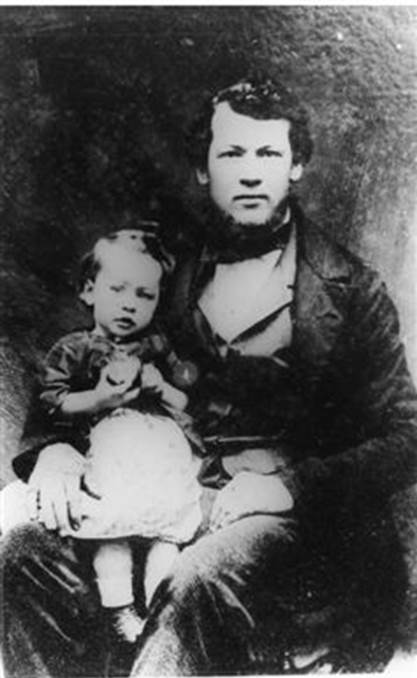
Henry and his fifth child Philip.
There also not always was “peace in the valley”. The Keilor court records, for instance, show that in August 1875 Henry took a certain Mary Rootsey to court for “unlawfully and maliciously throwing down a fence” that he had erected on his land. It was not a huge case but it is good to know that Henry won: Ms. Rootsey was fined to pay more than 2 pounds to compensate the costs. More intriguing is the court case of Patrick Seuling against Patrick McShane in August 1870 because the evil McShane illegally “detained a goat, property of complainant.” Genealogically, there is a slight issue: who is Patrick Seuling? The most probable explanation is that the friendly researcher of the Keilor Historical Society made a mistake, two Patrick’s in one court case of course is possible but more probably the complainant once again was Henry. Whatever, “we” came out the winners when the goat thief was ordered to deliver the animal and moreover had to fork over some 6 pounds to cover our costs.

Family tree of the Australian Seuling branch: descendants of Heinrich (Henry) Seuling (1826-1908).
The Seuling household of six children was completed by 1871 – the year in which Henry is referred to, twice, in correspondence between the local policeman Senior Constable Boyle and his District Superintendent. The first incident concerned the theft of a sack of pollard from the Seuling property by two men named Wilson and Stevens. Boyle and Seuling joined forces and caught up with the thieves fourteen kilometers away. When Henry tried to retrieve his property Wilson threatened him with a knife, then slashed the sack and let the pollard run out before he escaped. Despite the fact that Boyle worked hard and succeeded in capturing one of the men, there seems to have been ill feeling between him and the blacksmith, when Henry put his signature to a trumped-up charge against the policeman.
There was also animosity between him and local schoolteacher William Savage. The Seuling children were all educated locally and when State School 1578 opened in July 1875, Henry became a member of the Board of Advice. In this capacity he kept a watchful eye on the schoolmaster. The hostility may have been triggered by Inspector Gamble’s report on Savage’s teaching in 1875. When Savage responded to a comment about the children’s reading, he claimed Ann Seuling read well but the Inspector was prejudiced because of her German accent. This is a surprising claim as Ann was Keilor-born and however heavily-accented her father’s speech it would seem unlikely she would be affected.
Whatever the cause for their mutual dislike, by June 1878 Savage, who had suffered the ignomy of insolvency, was struggling to keep a night class going and wrote to the Education Department complaining of persecution by two members of the Board of Advice who spied on his classes. One was Seuling whom Savage claimed disliked him “because my shoeing custom is done at West’s”, one of Keilor’s four blacksmiths.
Henry’s dislike of Savage intensified when the latter was granted a piece of Crown Land at the October land sales and he himself missed out. He complained to the Lands Department and explained that Savage already owned two acres and that he, Seuling, was “not able to follow my occupation as blacksmith, six months ago I had an accident through a horse falling on me. If I get this land I intend to grow opium.”
This could account for the letter, two months later, the unhappy Savage who was moving towards a nervous breakdown, sent to his superiors which indicted Henry Seuling. After the schoolmaster had been fined for inaccuracies in his rolls, he wrote to Inspector Gamble saying that on the day in question two of the three absentees belonged to the Seuling family and that he was especially careful to mark their attendance correctly as “I have been credibly informed Mr Seuling makes his children keep a record not only of their attendances but also of a number of children at the school and compares them with my returns”.
An article in the 25 April 1930 issue of the Melbourne newspaper The Argus recounts how in the old days at Keilor Henry Seuling brought home a huge wedgetail eagle which he had killed with a stick while; with a mate it was slaughtering a flock of full-grown turkeys. The wedgetail eagle is a large and majestic bird that apparently had adopted a rather new style of dining. The enormous birds descended on a flock of turkeys, and with their powerful talons and beak, strike down two turkeys weighing in the vicinity of 10 pounds each and set to work for a royal feast. As turkeys roam the paddocks in search of thistle seeds, the report warns, it is only a matter of time before these huge monsters will clean up the flocks or be destroyed in some way or other.
A lighter side of Keilor’s life is revealed in letters, to which he was a signatory, requesting permission for the Keilor Select Quadrille Assembly to use the school for dancing every Friday night. Interestingly, it is also reputed that one of the first Petrol Engines built in Australia was hand-made at the Keilor Forge in the 1880’s. The cylinder was of brass with a forged connecting rod.
Meanwhile the older Seuling children were growing up and with the exception of second son John Caspar moved elsewhere in Victoria. By 1881 Mary had married a successful vigneron from Sunbury, named Felix Frederick (also: Francis) Bubeck, who had immigrated from the Stuttgart area in Germany in 1866. In one of those remarkable stories of ‘the old times’, Felix as a nineteen-year old was sent by his father to find wine-growing land. He purchased 60 acres at Diggers Rest and became a successful vintner. He planted about 40 acres of the land, then was followed by his parents Immanuel and Anna Maria (Kurrle), three brothers Gottol, Gotthardt and Christian and two sisters Wilhelmine and Ernestine. Father Immanuel unhappily passed away within half a year after arrival but the other family members rooted in their new home country. Their vineyard was named ‘Schlossberg’ and produced good wines (Trade Mark- Emu) A magnificent, extensive garden of trees, shrubs and sweet smelling flowers was established around the house. During the 1880’s a red wine gained an Honourable Mention Certificate at the exhibition in Bordeaux, France. The last Schlossberg vintage was in 1916.

A proud daughter Daphne tells the story of her father, Felix Bubeck.
The Schlossberg vineyard was on the slopes of Bald Hill. Apart from the luscious grapes, the property was noted for its magnificent display of daffodils, jonquils and other sweet smelling flowering bulbs. The Bubecks and their fellow vintners in the area benefited from the New Industry Act which provided assistance to people who wished to test the suitability of the land. The gently rolling country side, with rich volcanic soil, was ideal for growing wine grapes. Immigrants from European winemaking countries took up the land at one Pound per acre. Felix Bubeck first headed for the Murray Valley, then went south and bought the property on Bald Hill.


Two composite photographs, made up of postcards ‘stuck’ together, of the Schlossberg vinery at Diggers Rest near Sunbury.

‘Mud map’ of the lay-out of Schlossberg, possibly by Daphne.
Felix Bubeck died at Diggers Rest, at home 5th May 1918, aged 71 years. His wife, Marie Ellen Bubeck (Seuling) died 7th September, 1958, at her home, Cromwell Road, South Yarra, aged 97 years. They had no less than six daughters, Daphne (1885), Violet (1887), Frieda (1888), Mary (1891), Sylvia (1892) and Vera (1893).

Mary Ellen Seuling with husband Felix Bubeck and their daughters. Standing in the rear with her father is Daphne.
Of the seven sisters, Daphne was born on 30th May 1885 at Keilor. She married Frederick James Wilson on 16th May, 1911 at Sunbury. They had seven sons, these were – Lindsay Rothwell, Carl Frederick, Keith Rylott, Edgar Henry, Colin James, Neville George and Lionel Geoffrey. Daphne died 21st November 1957 in her home in Sale, Victoria. Her oldest son Edgar in turn married Coral Dawes and granddaughter Wendy, married with Ian Griffin, added further color to the more recent adventures of our Australian relatives.
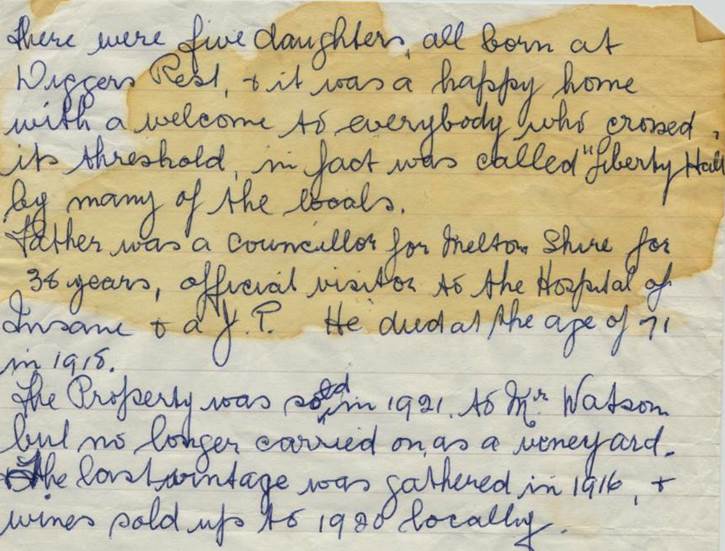
Daphne’s account of family life at the Bubeck residence.

Wedding picture of Daphne Bubeck and Fred Wilson; 1911, Sunbury.
The award for the most special photograph in the Seuling family book undoubtedly goes to the picture taken at the 25th wedding anniversary of Fred and Daphne in May 1936. As granddaughter Wendy Griffin explained: “It was in fact the first time the entire family was together. When Grandma was pregnant with her 5th child she wasn’t well and child 3 (Keith) was supposed to be sent to Melbourne to be looked after by one of Fred’s older sisters and her daughter. Keith had chicken pox or something at the time and couldn’t go, so Dad (Edgar) was sent. The result is a mystery to Dad. For some reason his parents never collected him. Either they decided they couldn’t afford to have him or the aunt refused to let him go, or some other unknown reason. So Dad grew up in Melbourne while his parents and 6 brothers were 3 hours away (much longer by horse and cart) in Sale (country Victoria). In fact the 7 boys were only ever together three times in their lives. The first in the picture above, the 2nd at Mum and Dad’s wedding in 1949 and a 3rd time at a cousin’s wedding in the 1970’s.”

The 25th wedding anniversary of Frederick Wilson and Daphne Bubeck, May 1936. This was the first occasion that all seven brothers were together at Marley Street, Sale. At the far left in the rear is Edgar.

Gran (Mary Ellen) Bubeck with Lindsay, the oldest son of Daphne and Fred Wilson, born in 1912.
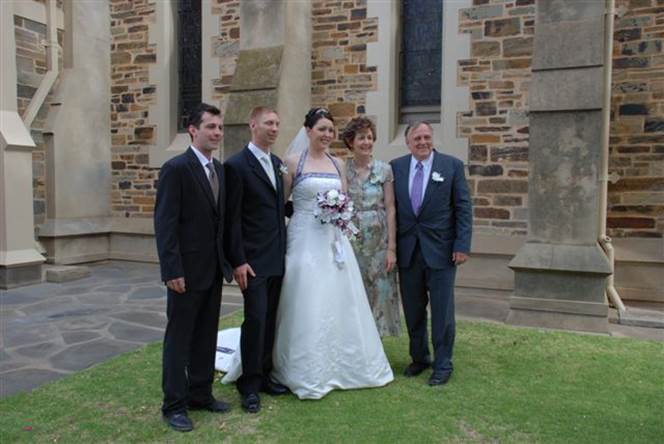
Correspondent Wendy Wilson with husband Ian Griffin at the wedding of daughter Kerryl with Chris Waters, with – at the left – son Anthony; 2007.
We have to pick up the story of the Australian Seuling branch with the oldest son of Henry and Ellen Leary, Henry (born in 1859) who in 1887 married Jane (also: Jean) Lennox. Three daughters Winifred, Irene Ethel and Helen (Nell) plus son Henry carried the family name into the next generation.

Group portrait of Australian Army Nursing Service (AANS) sisters from Qld, NSW, Vic, Tas, and SA, bound for Salonica, Greece on the RMS Mooltan; Adelaide, SA. June 1917. According to the website it is possible to distinguish SN Irene Ethel Seuling of Elsternwick, Victoria. For this purpose one must number all nurses, starting at front row, left to right with number 1. Irene then has number 115. We haven’t tried.
Brother Philip Augustus joined in matrimony with Mary Watson Weir; the records suggest they had no offspring. Youngest daughter Ann Elizabeth and her husband Charles Cornelius Lines had two sons and a daughter. Number six, Alfred Walter, married in 1902 with Louisa Emma Hollow. After their youngest son George died in infancy, the Seuling name was carried forward by daughters Amy, Elsie, and Ilma and son Henry.

Philip’s wedding is “quietly celebrated”; Melbourne Punch, February 28, 1895.

Mary Seuling-Watson passes away; The Argus (Melbourne), November 10, 1954.
Uncle Kaspar passed away in Keilor in 1896, presumably at Henry’s home. When Henry himself died in 1908, the Bubeck’s gave Ellen a home at their property “Schlossberg”, named no doubt after the famous vineyard in Austria, with its picturesque medieval castle atop the hill overlooking the vines on the lower slopes. Henry’s will indicates that he had not only reared six of his seven children in his new land but also left them a legacy. The old German migrant died, leaving six township blocks and an old house as well as seventeen acres nearby. In addition he had clearly been an active member of the community in his new country.
John Caspar took over the blacksmith’s shop. By that time he had already married Ann Goudie, the daughter of Scottish farmer and publican Matthew Goudie and his wife Jane Emmett. Ann was one of seven girls and two boys, who ran a school at their hotel. In fact John and Ann were licensees of the “Keilor Hotel” at one time and apart from his running the forge until the late 1930’s, also involved themselves in civic and church affairs. A cousin now owns the hotel that has been in the family since 1875, and their family farm is now a lovely public park.
The couple had five children, two dying in infancy. John and Ann unfortunately died in middle age and only daughter Clarice Ruby (called: Ruby), with the support of various aunts and uncles, played a marvelous role in bringing up her two younger brothers. Alfred Reginald served in Egypt and the Western Front during the Great War. Ruby’s son Bill was badly wounded in the New Guinea campaign and received an award for bravery. He never fully recovered from his injuries, however, and died in middle age.


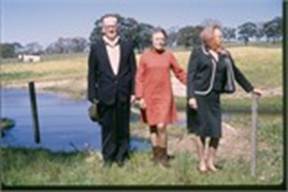
Left to right: wedding of Isabelle Kate Niven and Alfred Reginald Seuling, 1923; a later portrait of Alfred Reginald; and a pleasurable walk of Alfred Reginald Seuling, Thelma Joyce Fitcher-Niven, and Isabelle Kate Seuling-Niven.
Youngest child Philip (Phil; 1907-1994) married Josephine Margaret (Julie) Daly and grew up to be the father of our correspondent Diane and her brother John. He, as Diane wrote us, was a quiet unassuming man who grew up as a typical “Aussie” country lad, loving sport. After finishing his schooling, he joined the Public Service which proved to be a long career and for which he received an award when he retired. Memories of the Depression were bitter but when Phil moved to Melbourne he met Julie, a country girl from the gold mining town of Bendigo, in central Victoria. When war came to the Pacific, Phil joined the air force in 1942 at the time of the Battle of the Coral Sea, and was then shipped to Borneo, Indonesia. His unit was to move to Japan but the “Bomb” was dropped on Hiroshima and peace in the Pacific was declared. Only much later Phil made it to Japan as a tourist. One of the highlights of his life was his trip in the late seventies to the U.K. to watch the Australian Cricket Team play England and the West Indies.
In October 1993 the Keilor Historical Society honored the family’s memory by erecting a heritage panel on the site of the Blacksmith’s Shop, which the Seuling’s sponsored. Phil, who on the panel recalls how he “ran the rabbit” to get a billy of beer from the hotel, read the dedication. Phil continued part time work until he was 79 and passed away in August 1994, just prior to his 87th birthday. Julie, his spouse for almost 60 years, passed away in 1998.

Heritage panel honoring the Seuling family, Keilor, Victoria.

Phil Seuling with daughter Diane and son John at the dedication of the heritage panel in Keilor, 1993.


To the left, Julie and Phil Seuling at Gordon River, Tasmania, 1976; to the right, Diane, Emily (John’s daughter) and (grand)father Phil, 1987.
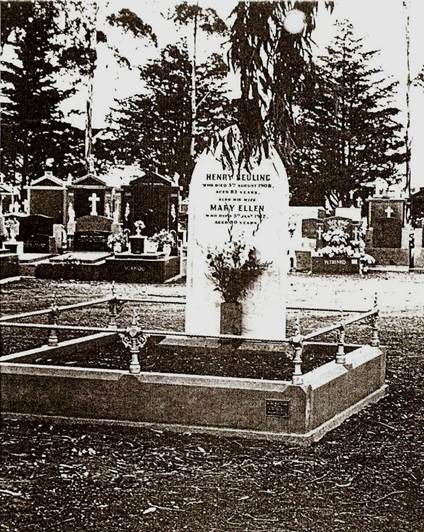
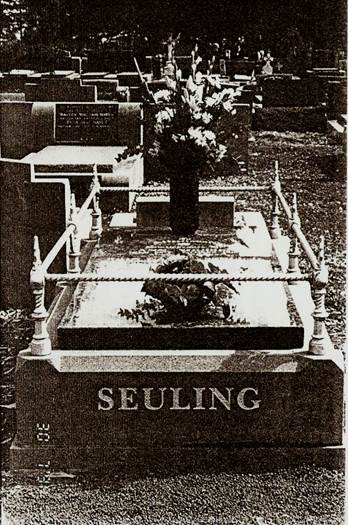
The graves of Henry and Ellen, and of John Caspar, Ann, and Philip at the Keilor Cemetery.
Much has changed since the first Seulings first set foot in Australia. Keilor no longer is a sleepy country town. It has all but become an outer suburb of Melbourne and as such is a large and bustling centre. With pride, descendant Diane Seuling speaks of her ancestry. “I have the greatest admiration for our pioneers who faced so many hardships to create a new life and society, the benefits which we enjoy today.” It was a long road from Alten-Buseck; one indeed can not imagine the choices to be made and the uncertainties faced by these relatives moving to the other side of the globe.
Johann Jost (Justus)
The youngest son of Johannes Seuling and Christine Voltz, Justus (1801-1873), apparently left the confines of Alten-Buseck and moved some ten kilometers closer to Gießen where he became the tenant of a small property belonging to the Badenburg. An engraving from that time shows the ruins of a water mill that, according to our sources, still exists today. The little stream is the Lahn that comes from Trohe and continues to Wieseck.
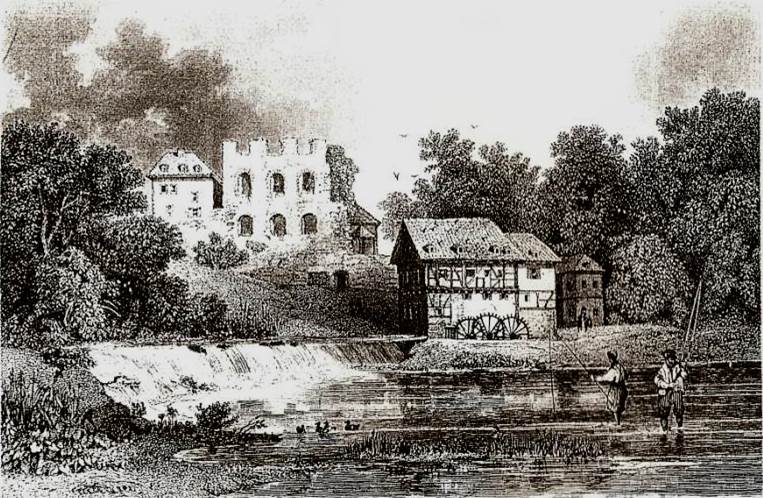
Ruins of the Badenburg.
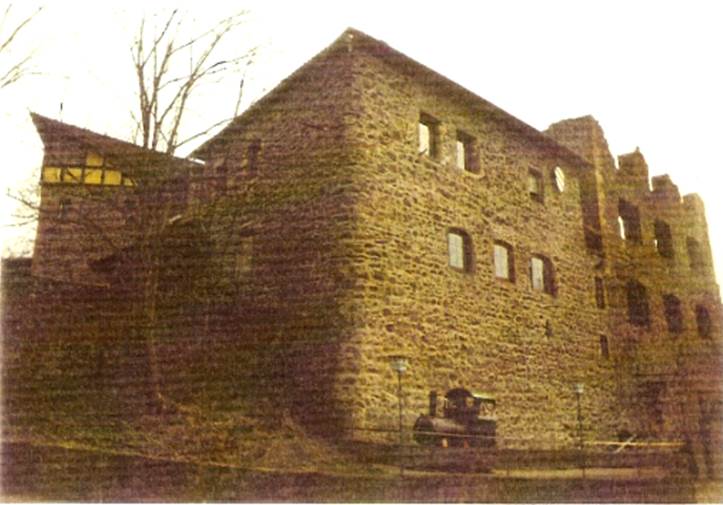
The ruins of the Badenburg today. Photograph by Annemarie Steinhäuser.

Sheep washing in the river Lahn at the Badenburg.
Justus married Christina Catharina Mühl. Beside an unnamed son who died at birth, their union resulted in five children. Son Balthasar (1838-1859) died young of unknown cause. Oldest daughter Katharina (circa 1818) joined forces with Johann Christoph Meyer; their offspring carried over to the 20th century. Second daughter Margaretha (1827-1883) married Johann Caspar Lepper and brought up son Heinrich and daughter Katharina.

Offspring of Johann Jost (Justus) Seuling.
More information is available on the offspring of oldest son Johann Heinrich (1823-1903), who – according to a hand written annotation in a family book of this Seuling branch by his grandson Wilhelm – grew up on the Badenburg. Wilhelm recalled how his grandfather often would tell that as a small boy he had to walk about an hour to go school in Wieseck and how much he had disliked it, especially when there was a lot of snow. He survived but did move back to Alten-Buseck. In 1849 Heinrich married Margaretha Geissler, from Alten-Buseck, and settled at the Flußgasse 21[1].

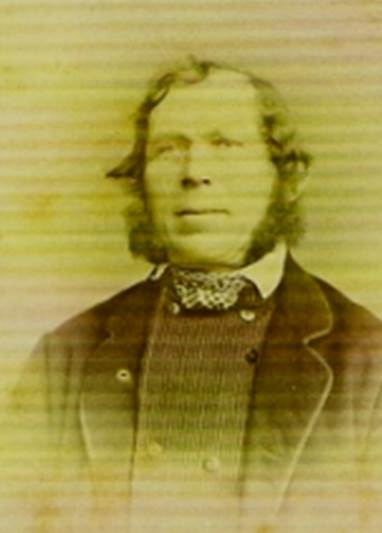
Portraits of Johann Heinrich Seuling (1823-1903) and his son “Lustige Ludwig” Seuling (1853-1923).
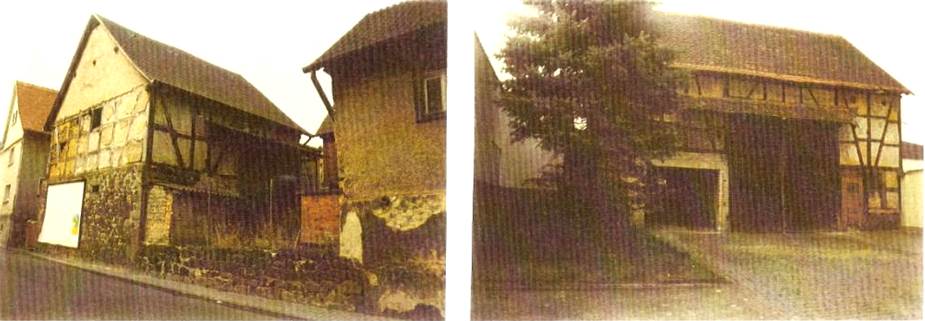
Photographs by Annemarie Steinhäuser of a neighboring house and the barn behind the ancestral home of Johann Heinrich Seuling at the Flußgasse 21 in Alten-Buseck.
[1] According to Annemarie Steinhäuser, the last family owner Marie Cloos (a daughter of the sister of Ludwig Seuling) sold the Stammhaus and Bauernhof in Alten-Buseck around 1970. The house was erased and replaced by a new construction.
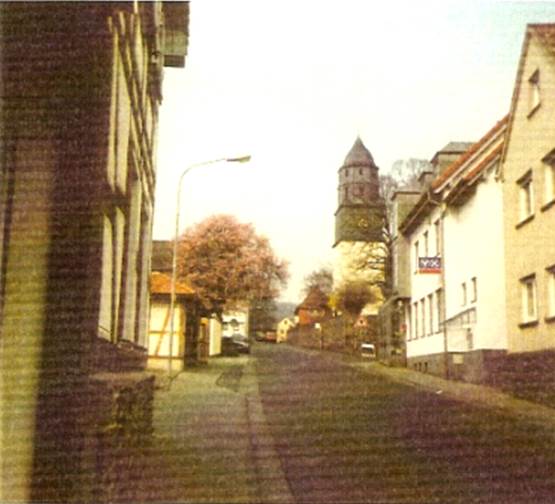
Photograph by Annemarie Steinhäuser of the Flußgasse in the direction of the Sebastian Kirche.
Heinrich and Margaretha Geissler had seven children, four of which grew up.

Offspring of Heinrich Seuling (1823-1903).
Oldest child Margaretha (born 1850) married Ludwig Geissler; her sister Maria Elisabetha (1855-1922) did the same with Ferdinand Schwalb. The latter union produced six children, at least three of whom became old enough to have families of their own. Nothing is known on descendants of Margaretha and Ludwig Geissler.

Offspring of Maria Elisabetha Seuling (1855-1922).
Especially oldest son Ludwig (1853-1923) lived on through his offspring. As a matter of fact, with the help of his granddaughter Ms. Annemarie Steinhäuser[1], we for the first time could connect a branch of the Seulings that today still live in Germany, with their roots in Alten-Buseck. Ludwig grew up to be an architect. In and around Gießen he built more than 50 houses of which 28 still figure prominently on the list of protected buildings today. The others were destroyed during the war. Nicknamed “Lustige Ludwig”, he must have been a remarkable person. He, for instance, was the first Hochrad-Fahrer in Gießen. It must have been a virtual sensation; only around 1880 the first steel bicycles were produced.
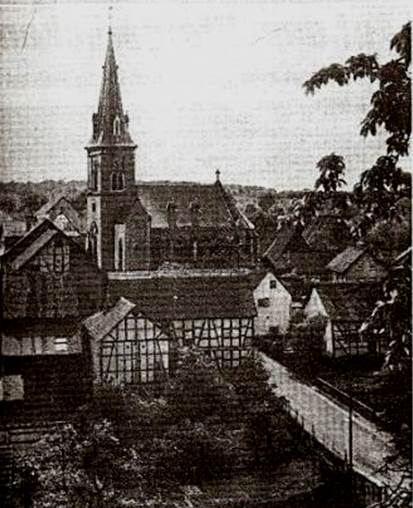
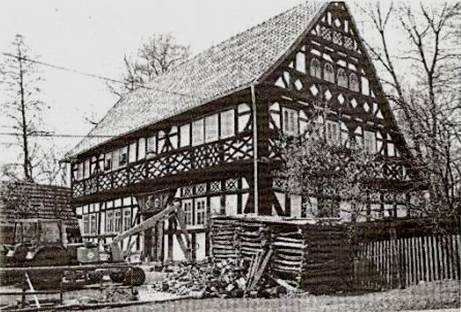
The church in Annerod that was designed and built by Ludwig Seuling. Also pictured is the beautiful Teufelsmühle (Devil’s Mill) in Ilbeshausen; as yet we do not know the connection with the Seuling family.
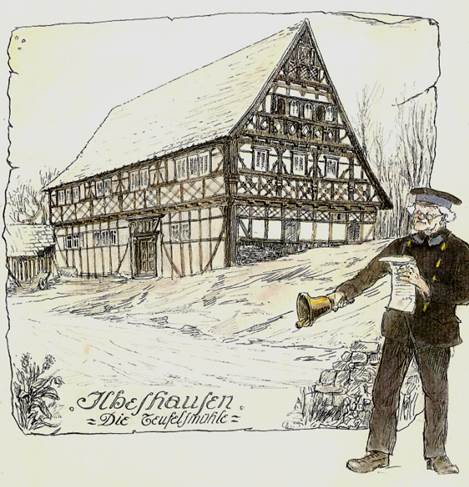
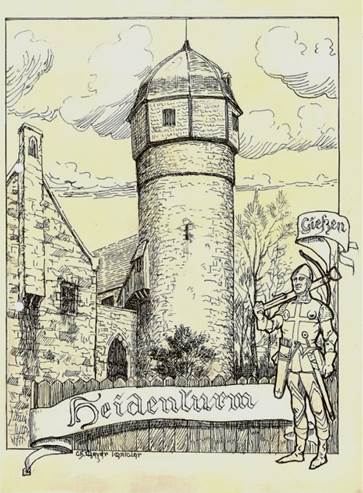
The Teufelsmühle in Ilbeshausen and the Heidenturm in Gießen, from the familybook by Wilhelm Seuling. Again the connection of the mill with the Seuling family is unclear.
In 1881 Ludwig, at the time still Bauaufseher while studying for architect in Gießen, married Katharina Schwarz from nearby Trohe where her father Georg was the mayor. Witnesses are Ludwig Schwarz, probably her brother, and Ferdinand Schwalb, the bridegroom’s brother in law.
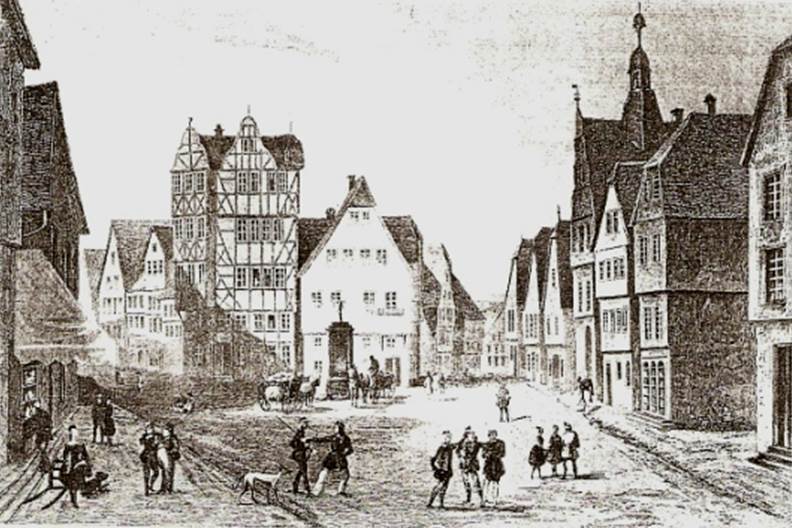
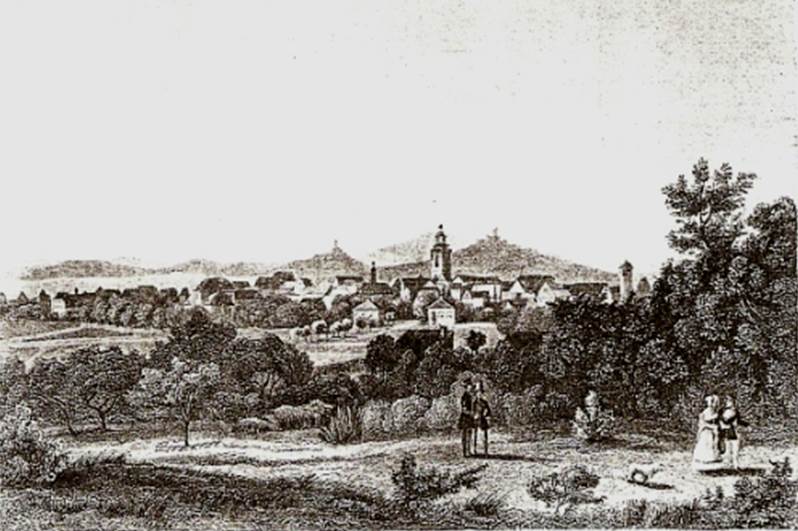
Engravings of Gießen in the middle of the 19th century.
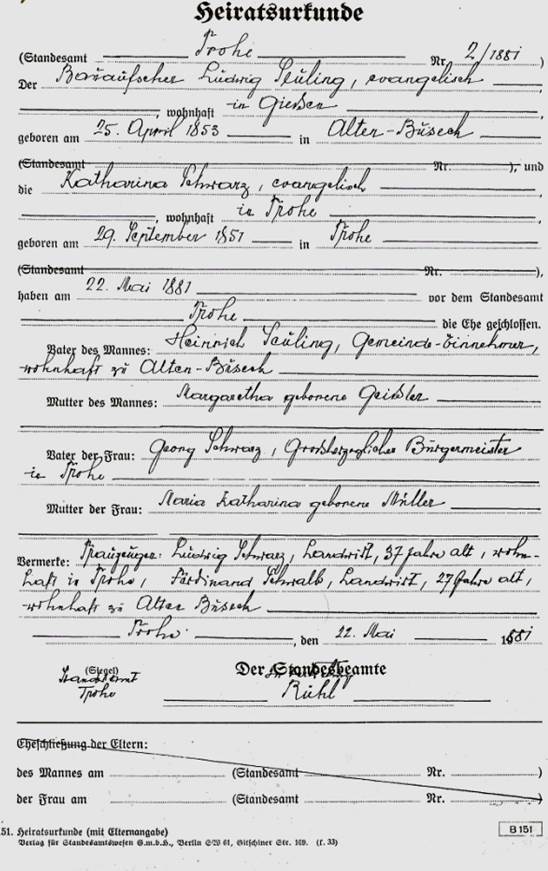
Marriage certificate of Ludwig Seuling and Katharina Schwarz; Trohe, May 22, 1881.
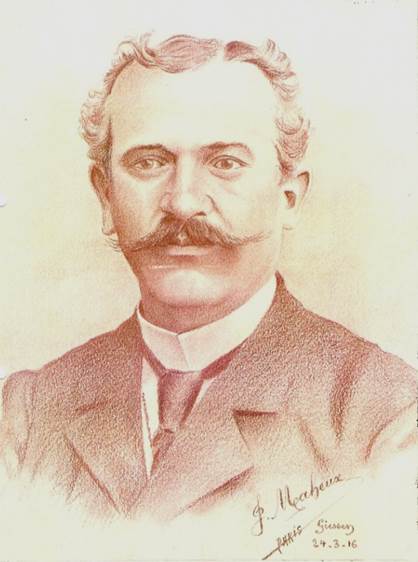
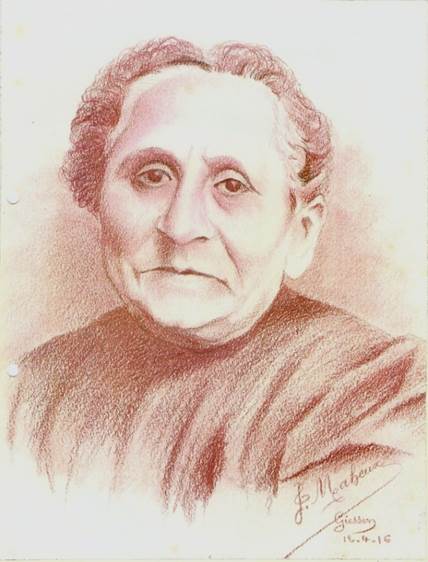
“Rötelzeichnungen” of Ludwig Seuling and his spouse Katharina Schwarz, from the familybook by their son Wilhelm.
Ludwig and Katharina had four children: Annemarie’s mother Else (born in 1883), Wilhelm (1884), August (1889) and Marie (1893). The photographs from the album of Wilhelm that we received from grandchild Annemarie Steinhäuser provide an image of a happy family. A lovely picture from just before the turn of the century sees the children posing with the family dog. A few years later Else went with her parents to the Sommerfest in Stein’s Garten; in 1904 she married Ludwig Steinhäuser. However, when August looks over the shoulder of his oldest sister behind her writing table and drinks tea with Marie and his sister in law Anna (married to brother Wilhelm) in 1915/6, he wears a military uniform. Brother Wilhelm, by this time graduated from medical school, also served his country as a military doctor; we see him posing in his uniform and arm in arm with a proud father. Indeed, World War I must have put considerable strain on the otherwise peaceful life of Katharina and Ludwig. Shortly before he passed away in 1923, the elderly couple is photographed in their backyard. Katharina survived him and died in 1934.
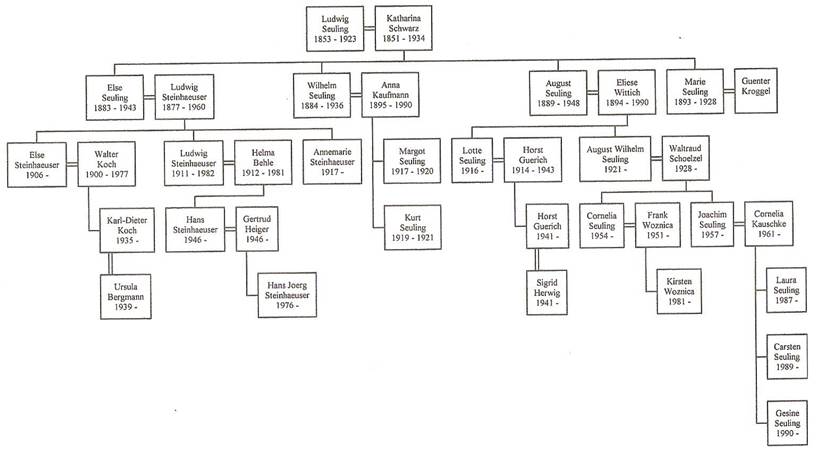
Offspring of Ludwig Seuling (1853-1923).
[1] We are grateful to our German cousin Annemarie Steinhäuser in Wuppertal, Germany, for providing us with the information on this German branch.
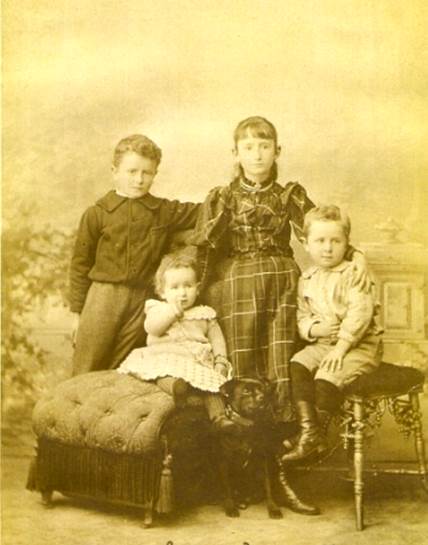
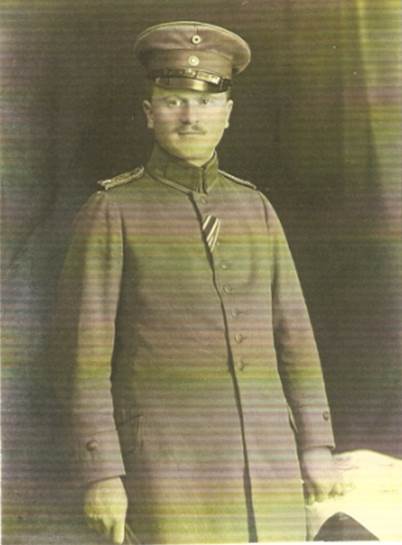
To the left, the four children of Ludwig and Katharina Seuling; from left to right: Wilhelm, Marie, Else, and August. Gießen, about 1895. To the right, Dr.med. Wilhelm Seuling 1915 im Krieg Militar-Arzt.
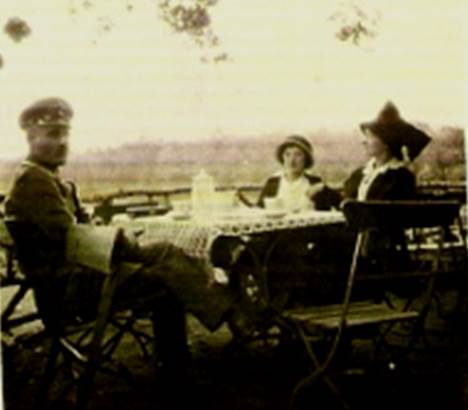
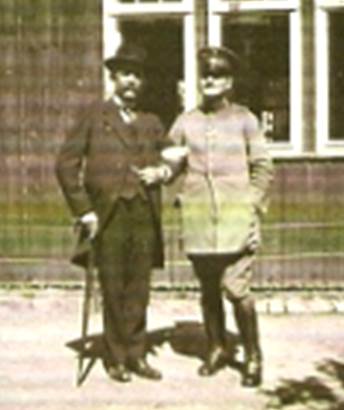
To the left, August Seuling, Anna Seuling-Kaufmann and Marie Seuling on a sunny day in 1916; to the right, Ludwig and Wilhelm Seuling, 1915.
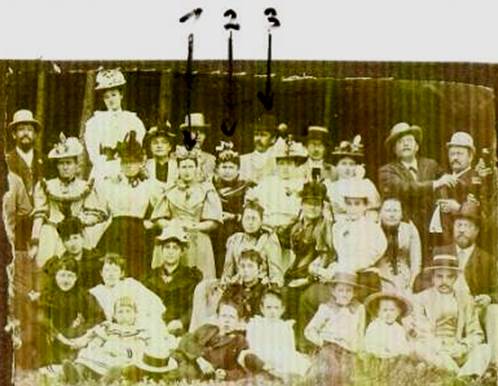
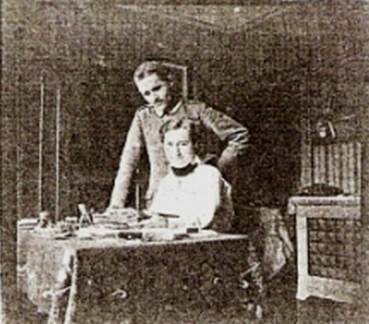
To the left, Sommerfest in Stein’s Garten in Giessen, ca. 1898, including Else, Katharina and Ludwig Seuling (indicated by arrows from the top); to the right August and Else Seuling, 1915/1916.)
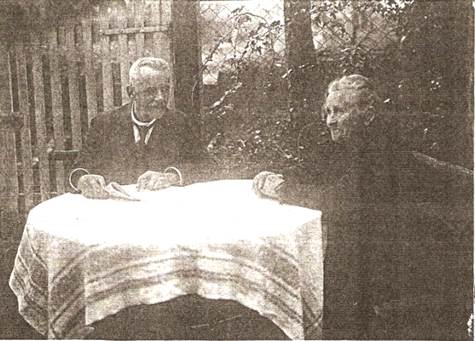
Ludwig and Katharina Seuling, around 1920.
The children all created families of their own. Oldest daughter Else and her husband Ludwig Steinhäuser had daughter Else (1906; married to Walter Koch), son Ludwig (1911); married to Helma Behle) and our favorite German cousin Annemarie (1917). Annemarie never married. Again the Second World War left deep scars as her fiancee, after being released from a Russian prisoner of war camp in 1952, never regained his health and passed away in 1954. Annemarie also provided a personal testimony to the so-called Wirtschaftswunder, the remarkable recovery of the German economy through the efforts of millions individuals. Already in 1948 she established her first business enterprise in office supplies and toys (“Schreib- und Spielwaren”) that she subsequently built into a wholesale business with a retail outlet chain. Following her retirement in 1983 she has more time to spend on her favorite hobby, painting, which as evidenced by her results, she did with remarkable skills and talent.
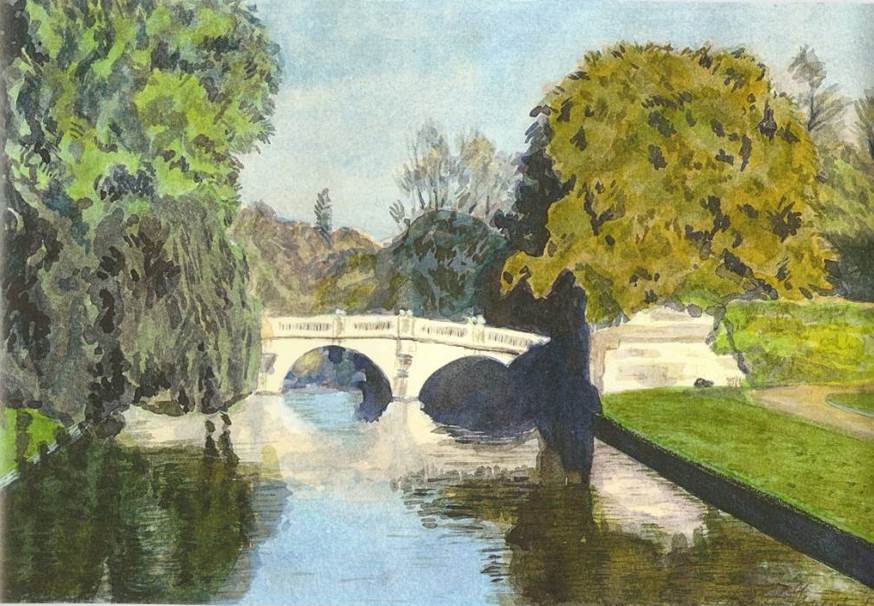
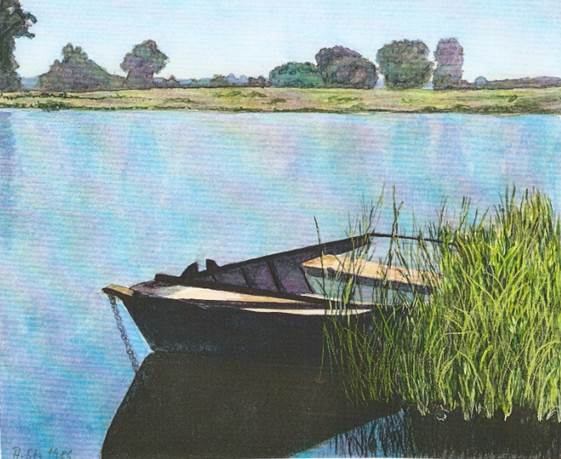
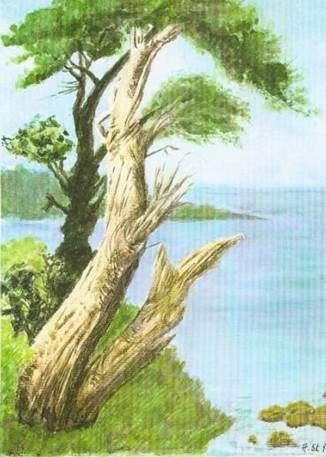
Paintings by Annemarie Steinhäuser.
Little is known of Marie (1893-1928) and her husband Günter Kroggel. She died young, in her mid thirties; her husband apparently emigrated to the U.S.A. Her brother August (1889-1948) succeeded his father as architect in Gießen. From his marriage to Elise Wittich he had daughter Lotte (married to Horst Gürich who died during the Second World War) and son August Wilhelm who became Oberstudiendirektor in Gelnhausen. His wife Waltraud Schölzel was the happy mother of daughter Cornelia (married to Frank Woznica) and son Joachim who, living in Koblenz, is Hauptmann in the Bundeswehr and also an accomplished photographer. With grandson Carsten, born in 1989, August Wilhelm and Joachim are the only male “survivors” among the descendants of Ludwig Seuling.

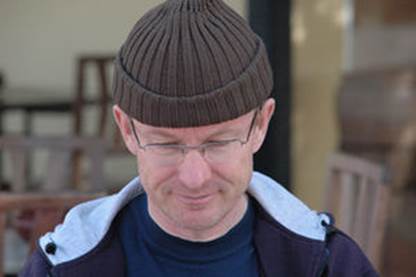
August Seuling (1921-2001). Joachim Seuling (born 1957): selfportrait.
Wilhelm, the oldest son of Ludwig Seuling and Katharina Schwarz, was born on December 5, 1884 in Gießen. He went to the Realgymnasium and also studied medicin in his hometown as well as in München, Leipzig and once again Gießen. In the summer of 1907 he did the ärtzliche Vorprüfung, in 1910 the ärtzliche Staatsexamen and in 1911 he obtained his doctor degree. In 1916 he married in Schotten, Oberhessen with Anna Kaufmann. The next years they have daughter Margot and son Kurt who both die very young, however, two or three years old.
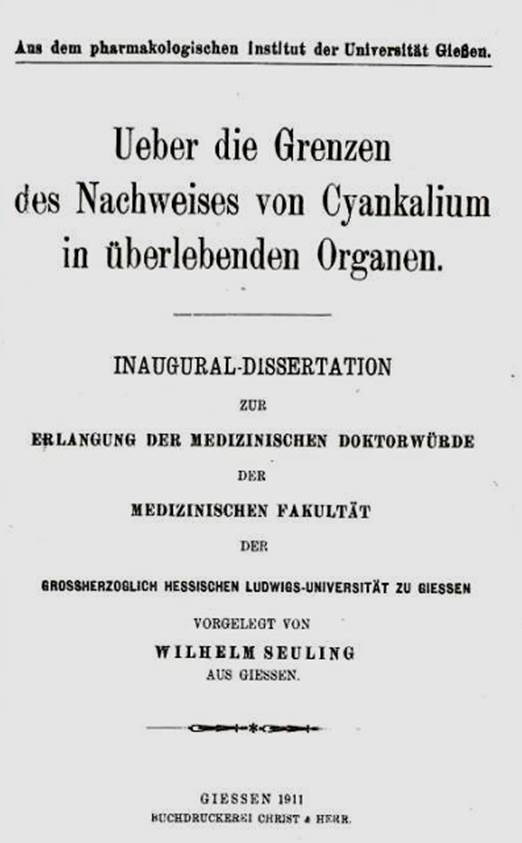
Title page of the doctor thesis of Wilhelm Seuling; Gießen, 1911.
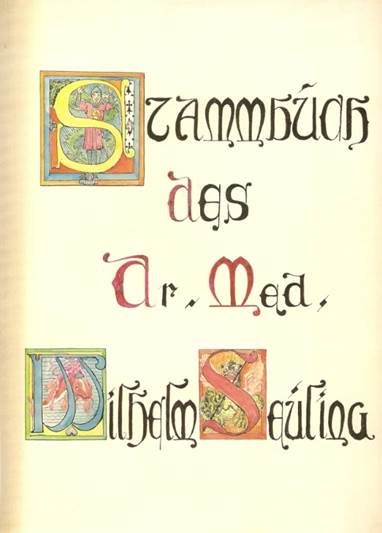
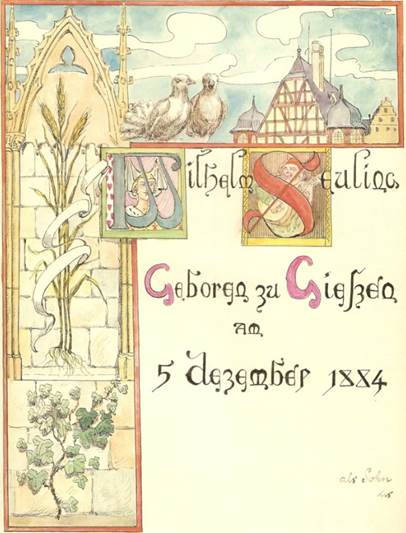
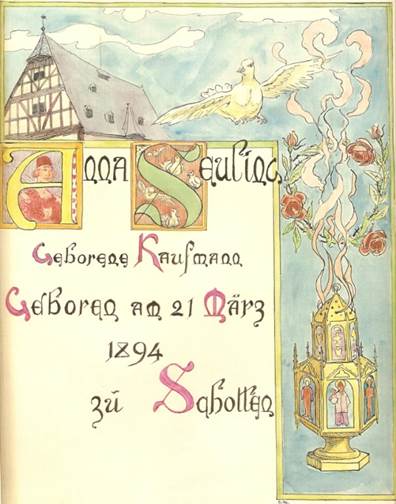
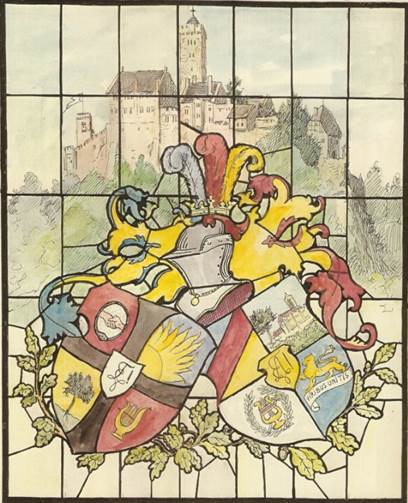
The opening pages of the Stammbuch (familybook) drawn by Wilhelm Seuling, a 2½ kilo album bound in leather with metal “Beschlägen” and two locks. The year of birth of Wilhelm’s spouse Anna Kaufmann – funnily – is mistaken as it should read 1895 (see page 3). Shown on page 4 are the “Wappen” of the student fraternity of which Wilhelm was a member, with in the background an artful sketch of the Wartburg castle near Eisenach.
Wilhelm became a highly respected and beloved medical doctor with a large practice in and around Schotten. He also must have been a most remarkable human being, a lover of books, collector of stamps and antiques, and a gifted musician. He, for instance, founded a large amateur orchestra in Schotten that eventually performed during a major family celebration of the Großherzog of Hessen in Darmstadt. Niece Annemarie vividly remembers from the many holidays that she spent with her favorite uncle and aunt (“ my Patentante”) how her uncle almost every Sunday morning would teach music to the children of his community in his music room. If the parents, often poor farmers, could not afford the instruments, he would donate them.
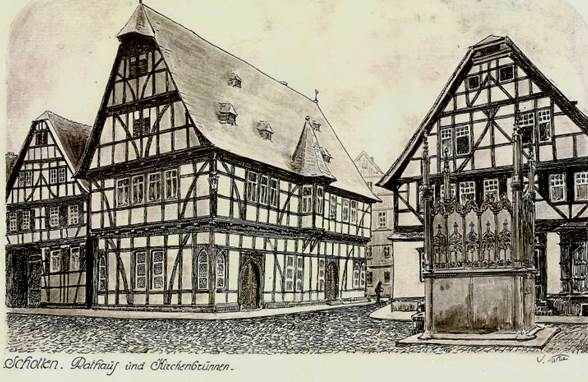
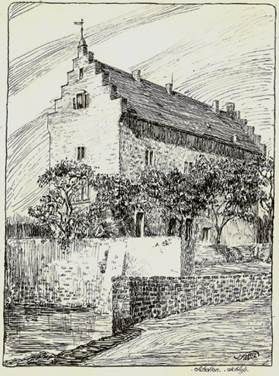
The Rathaus and the castle in Schotten, from the familybook by Wilhelm Seuling.
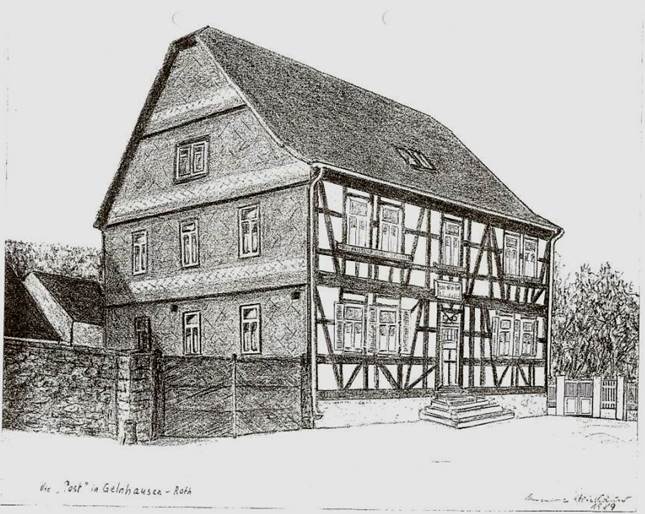
Drawing by Annemarie Steinhäuser of “Die alte Post”, the Kneipe annex post office in Gelnhausen-Roth that currently is protected as a historical building. Drawn from a postcard; 1989.
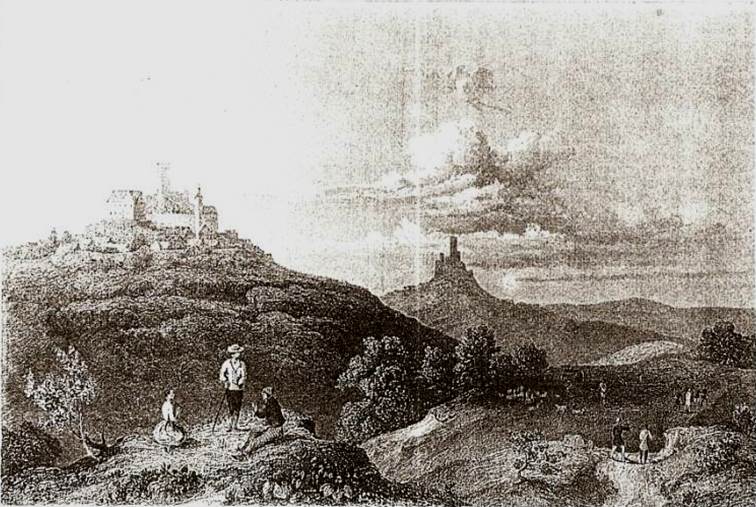
Engraving of Gleiberg and Vetzberg, just northwest of Gießen, from the family book of Wilhelm Seuling.
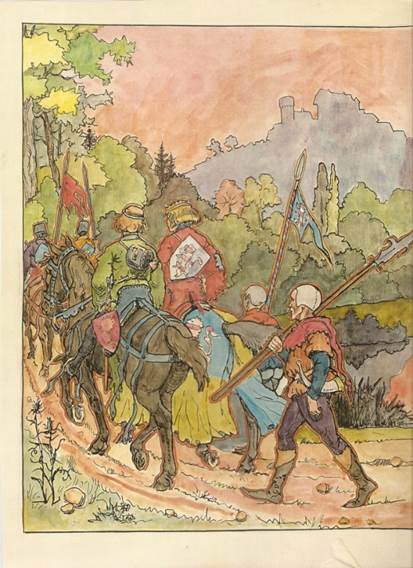

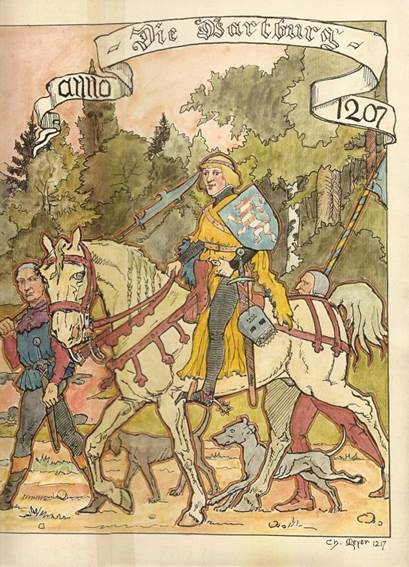
Two-sided aquarel from the familybook by Wilhelm Seuling, showing the journey of the knights to the Wartburg, a motive from the opera “Tannhäuser oder der Sängerkrieg auf der Wartburg” by Richard Wagner. The date 1217 next to the signature by the artist Meyer should read 1917; Mr. Meyer probably still had in mind the year 1207 that he skillfully drew in the top right hand corner.
In the 1930s the course of political events changed the lives of the happy couple. Anna was of Jewish descent. Faced with increasing hostility in Hitler Germany, Dr. med. Seuling gave up his practice in 1935 and left with his wife to Hamburg in order to emigrate to the United States. While in Hamburg he died, however, in October 1936. Anna left for the USA in 1940 and later was nationalized. In 1955 she returned to Germany; she passed away in 1990 in Frankfurt/Main. Annemarie managed to save Wilhelm’s family book during the 1943 bombardments on Wuppertal which she happily will pass on to the last males in this Seuling branch, Joachim and his son Carsten.
During her stay in New York, Anna Seuling-Kaufmann happened to meet an elderly gentleman named Seuling, who at the time was a nurse in a hospital. He died a few years later. Later, after much studying, it became apparent that this Mr. Seuling actually, unknown to her, was her uncle, i.e., the younger brother Wilhelm (formally: Karl Friedrich Wilhelm; 1866-1950) of Ludwig who at a young age had emigrated to the USA and in later years lost contact with his German relatives. Annemarie’s family owned a large framed picture of the two brothers that, however, was destroyed when the family home in Wuppertal was bombed on the night of June 25/26, 1943.
The offspring of Justus Seuling (1801-1873)
Much less we currently know of a further Seuling branch that stayed closer to home, near Alten-Buseck and that originated from the second son of Justus and Christina Mühl, the Maurermeister Elias (1829-1880). His marriage with Elisabetha Schreiner clearly was quite productive; no less than fourteen children were born to the couple who in 1860 and 1871 had taken up residence at a house named Lièse (Elias’s) at the Brandgasse 11.

Offspring of Elias Seuling (1829-1880).
At least seven children grew up to be old enough to have offspring of their own. Remarkably – and for reasons that as yet we do not know: was it childbirth? – some girls died at a fairly young age. As a matter of fact, oldest daughter Margaretha (1855-1928) is the one exception. Actually, her marriage with Christoph Schmidt, the Werkmeister (supervisor) at the Alten-Buseck cigar factory, clearly moved the Seuling family into the higher social ranks in the Busecker Tal. Their son Heinrich (born 1896) became mayor of Alten-Buseck, his older brother Ferdinand (1886) in nearby Rödgen. In 1887 Christoph and Margaretha had moved into Lièse where they still lived in 1910.
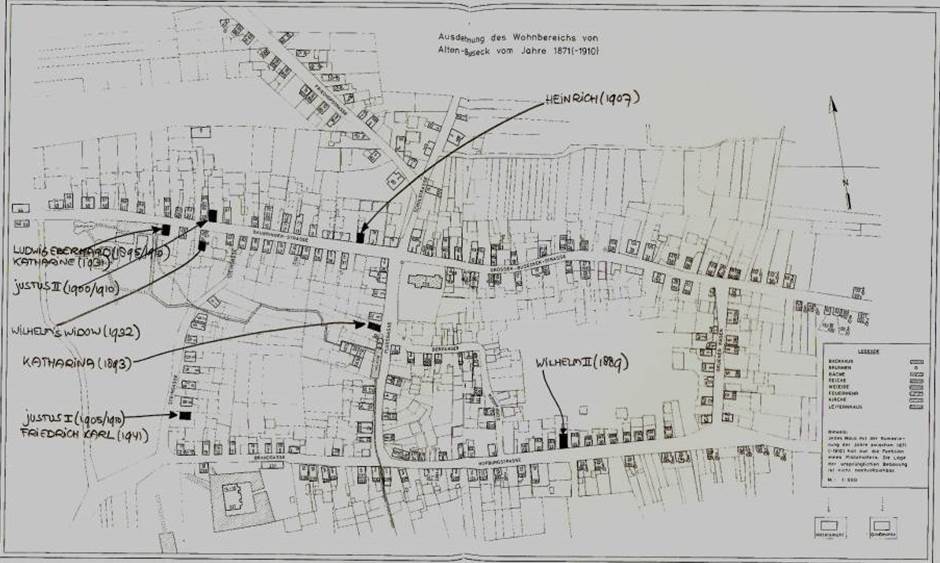
Residencies in Alten-Buseck, 1871-1910.
[1] The information on this first American branch was kindly provided by Karl’s youngest son William Seuling and his spouse Luise who well into their eighties lived in Boynton Beach, FL, and by Mrs. Margaret McKenna Seuling in Lake Grove, NY .

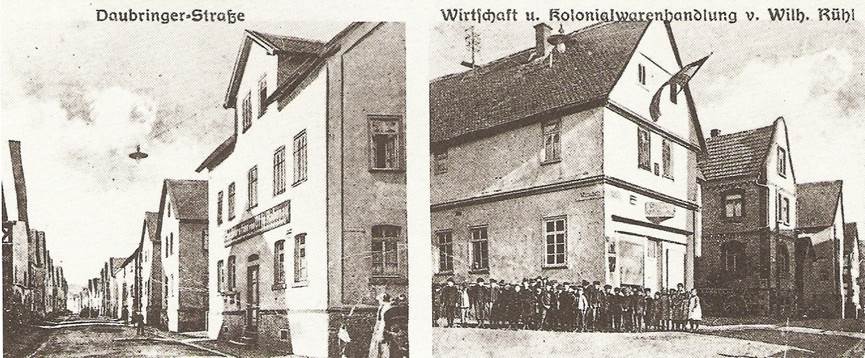
Postcards from Alten-Buseck provide views in the directions of the Daubringer and Großen-Busecker Straße, right.

The Schmidt family around 1910. In the back row we see, from the left, Katharine Lepper-Schmidt (born 1889), Margarete Schmidt (1880), Marie Wagenbach-Schmidt (1884), Wilhelm (1894) and in the front row Heinrich Schmidt, later Bürgermeister of Alten-Buseck (1896), the parents Margarete Seuling (1855) and Christoph Schmidt as well as Ferdinand Schmidt, later Bürgermeister of Rödgen (1886).

Heinrich Schmidt (1896) from the Brandgasse 11 pictured in his function of policeman. Before serving as a policeman from 1928 to 1933, he worked at the Didier-Werke in Mainzlar. From 1933 to 1945 he owned a small agency, selling bicycles, sewing machines and radios. Between March 1945 and December 1961 he was mayor of Alten-Buseck.
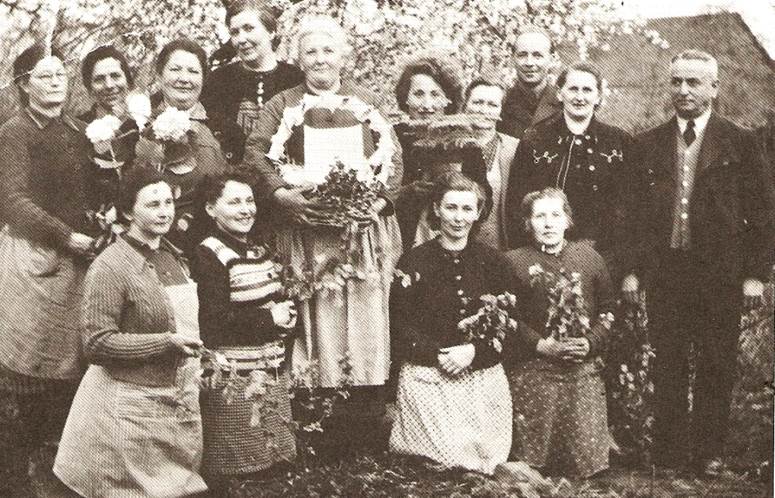
The 25-year anniversary as Waldarbeiter of Anna Muhly born Rupp (*1899) on April 13, 1953. Joining the celebrations are Anna Marscheck, Marie Semmler, Katharine Wagner, Wilhelmine Goß, Anna Muhly herself, Margarete Häuser, Hedwig Röhrich, Förster Fröhlich, Anna Opitz, Altbürgermeister Heinrich Schmidt and kneeling: Hedwig Müller, Agnes Frank, Irena Stekker and Marie Pfeiffer.
Her sisters Maria (1857-1880), Katharina (1858-1876), Elisabetha (1869-1904), and Maria Elise (1873-1893) must have been cause for much sorrow within the household of Elias and his Elisabetha. As yet we do not know of any weddings or offspring along the female lines. Of the boys it appears that only Ludwig Eberhard (1862-1938) and Justus (1866-1926) to our knowledge passed the age of twenty. We have not uncovered any further traces on the latter.
Ludwig and his bride Katharina Becker remained in Alten-Buseck where they lived at Daubringer Straße 30 in a house named “Grölze” that was torn down since then. His professions are given as “Landwirt” and “Kuefermeister”: farmer and cooper (barrel-maker). We have no further information regarding his life but do know that he committed suicide by hanging himself in 1938 in Giessen.
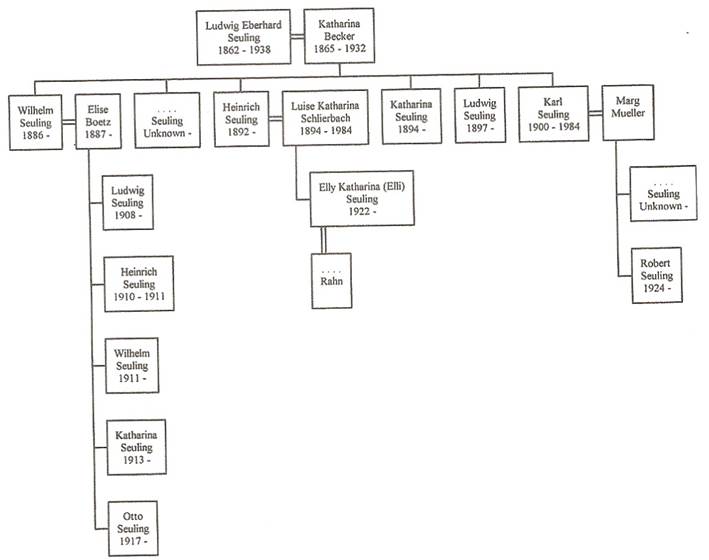
Offspring of Ludwig Eberhard Seuling (1862-1938).
At least three sons created families of their own. In 1910 Wilhelm (born in 1886) married Elise Bötz; in a picture dating back to 1915 we see them in front of the house they rented on Hofburgstraße 35. In 1932 we note that Wilhelm Seuling’s spouse lives in the Daubringer Straße 24; although we are not completely sure this is Elise, the previous owner of the house was Kaspar Bötz II. Some of his descendants still live today but our information is sketchy. Photographs from the first decades of the 20th century show Wilhelm (born 1911), Katharina (1913) and, just before the Second World War, Otto (1917). In 1931 Katharine had moved into the house that apparently was vacated by her parents.

On this picture of Hofburgstraße 35, taken around 1915, we see posing in the windows, from the left, Heinrich Dechert, Werkmeister and Gemeinderat (1868-1927) and his wife Marie Gerhard (1874-1956). Standing in the street are their renters Wilhelm Seuling (born 1911; in 1986 living in Wieseck), his mother Elise Seuling-Bötz (1887-1949), Katharina Vogelhöfer (1913; in 1986 in Wieseck) and her – eventual – husband Kaspar Dechert (1898-1940).
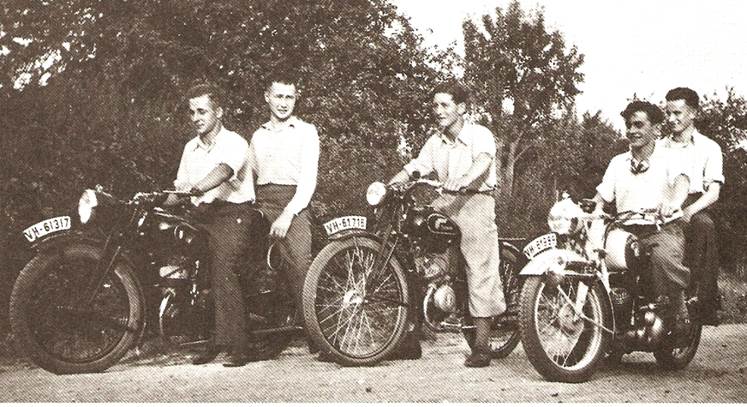
Motorcycle fans on the Hofburgstraße (1938). At the left, sitting on a DKW, are Wilhelm Vogel (killed in action) and Otto Seuling. Wilhelm Schäfer (killed in action) rides a Torpedo, and on a Zündapp we see Karl Vogel (killed in action) and Heinrich Stecker. This last “Machine” is equipped with a two-tone horn.
Second son Heinrich (born in 1892) apparently had only one daughter, Elly Katharina (1922), who later married a Rahn. In a beautifully posed photograph of 1933 we see him as one of the worthy members of the bowling club “Gut-Holz”.
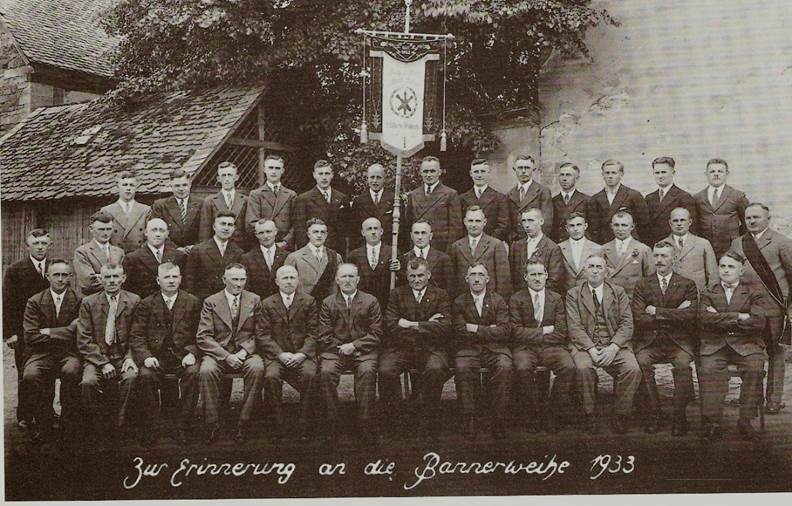
Kegel-Klub “Gut-Holz” Alten-Buseck, 1933. Third from the right on the front row is Heinrich Seuling.
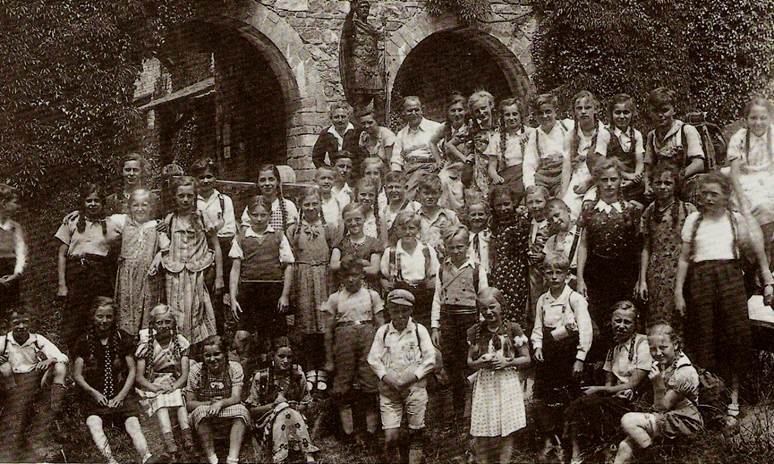
School trip to the Saalburg/Taunus, 1935. Difficult to identify, the second person from the right on the third row (out of five) is Elli Seuling who later married . . . Rahn.
Third son Karl (1900-1984, always Alten-Buseck) married Marg Müller and had a son Robert (1924). From 1914 until 1917 he was an apprentice in a bookbinding shop; from June until December 1918 he served during the final months of World War I. After the war he again worked as a bookbinder, but after 1930 the economic crisis resulted in his joblessness. He survived by farming in Alten-Buseck. As a member of the KPD he was elected to the Landtag of the Volkssaat Hessen during the Weimarer Republik from 1932 till 1933. Following the coup of the Nationalsozialisten he was briefly arrested. From 1939 until the end of Worl War II he again served in the German Army; after the war he worked for the Versorgungsamt Gießen and the government.

Karl Seuling.
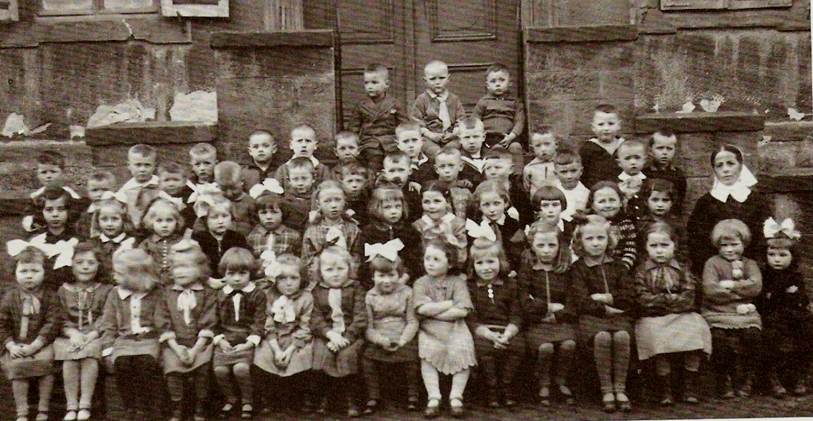
The “little” sister Berta in 1928 with the group 1923/1924/1925. Second from the left on the third row, almost hidden behind the girl with the most beautiful bow of the class, is little Robert Seuling.
In the meantime youngest son, Justus (1866-1926), started a family of his own with Maria Vogel. None of their six children survived, however. After Maria passed away around 1900, Justus remarried with Maria Katharina Balser. In 1905 and 1910 they lived in a house named Hörese in the Schulstraße 20. Another seven children were born, many of whom once again died at a very young age. It is possible, however, that son Otto (born 1911) grew up; in 1941, his younger brother Friedrich Karl (1912) had moved into his parents’ home.


Offspring of Justus Seuling (1866-1926).
